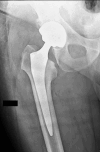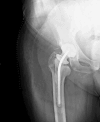Psoriasis and Canine Exposure Leading to Recurrent Prosthetic Joint Infection: A Case Report
- PMID: 40979037
- PMCID: PMC12448262
- DOI: 10.7759/cureus.90595
Psoriasis and Canine Exposure Leading to Recurrent Prosthetic Joint Infection: A Case Report
Abstract
Prosthetic joint infection (PJI) is a severe complication following total hip arthroplasty (THA), often requiring extensive medical and surgical intervention. This report presents a case of recurrent PJI associated with an untreated psoriatic lesion and habitual canine contact, highlighting an unusual yet significant vector for microbial transmission. A 51-year-old male patient underwent a primary total hip replacement in January 2024. Three weeks postoperatively, he developed a PJI caused by Streptococcus agalactiae. Despite a two-stage revision arthroplasty, recurrent infections were noted over the following months, with cultures later identifying Staphylococcus aureus and Staphylococcus xylosus. During hospitalization, the patient disclosed a longstanding psoriatic lesion on his knee, which he frequently scratched and allowed his dog to lick. Dermatological consultation confirmed psoriasis, and the association between his skin condition and bacterial transmission from his pet was suspected to contribute to the persistent infection. The patient demonstrated clinical and biological improvement following prosthetic revision and targeted dermatological management. This case emphasizes the importance of dermatological evaluation in patients undergoing joint replacement, particularly those with chronic inflammatory skin diseases such as psoriasis. Additionally, it underscores the need for thorough patient education on zoonotic bacterial risks. Recognizing the role of dermatological integrity and pet-associated bacterial transmission in PJI can enhance preoperative risk assessment and postoperative care strategies.
Keywords: canine; prosthetic joint infection; psoriasis; total hip arthroplasty; two-stage revision; zoonotic transmission.
Copyright © 2025, Majid et al.
Conflict of interest statement
Human subjects: Informed consent for treatment and open access publication was obtained or waived by all participants in this study. Conflicts of interest: In compliance with the ICMJE uniform disclosure form, all authors declare the following: Payment/services info: All authors have declared that no financial support was received from any organization for the submitted work. Financial relationships: All authors have declared that they have no financial relationships at present or within the previous three years with any organizations that might have an interest in the submitted work. Other relationships: All authors have declared that there are no other relationships or activities that could appear to have influenced the submitted work.
Figures





References
-
- Periprosthetic joint infection. Kapadia BH, Berg RA, Daley JA, Fritz J, Bhave A, Mont MA. Lancet. 2016;387:386–394. - PubMed
-
- The operation of the century: total hip replacement. Learmonth ID, Young C, Rorabeck C. Lancet. 2007;370:1508–1519. - PubMed
-
- Patient-related risk factors for periprosthetic joint infection and postoperative mortality following total hip arthroplasty in Medicare patients. Bozic KJ, Lau E, Kurtz S, Ong K, Rubash H, Vail TP, Berry DJ. J Bone Joint Surg Am. 2012;94:794–800. - PubMed
-
- The management of peri-prosthetic infection in total joint arthroplasty. Toms AD, Davidson D, Masri BA, Duncan CP. J Bone Joint Surg Br. 2006;88:149–155. - PubMed
-
- Periprosthetic joint infection rates across primary total hip arthroplasty surgical approaches: a systematic review and meta-analysis of 653,633 procedures. Acuña AJ, Do MT, Samuel LT, Grits D, Otero JE, Kamath AF. Arch Orthop Trauma Surg. 2022;142:2965–2977. - PubMed
Publication types
LinkOut - more resources
Full Text Sources
